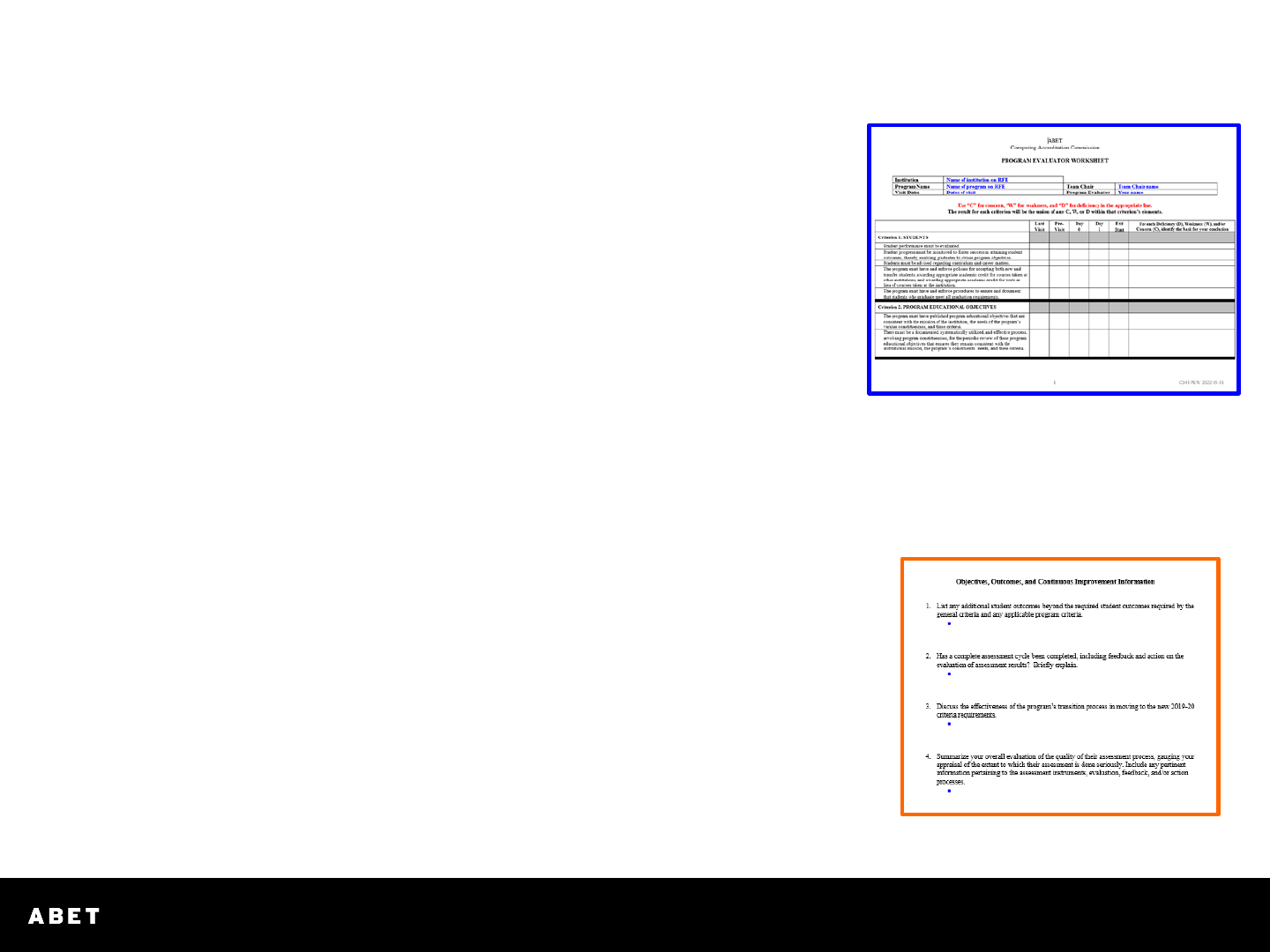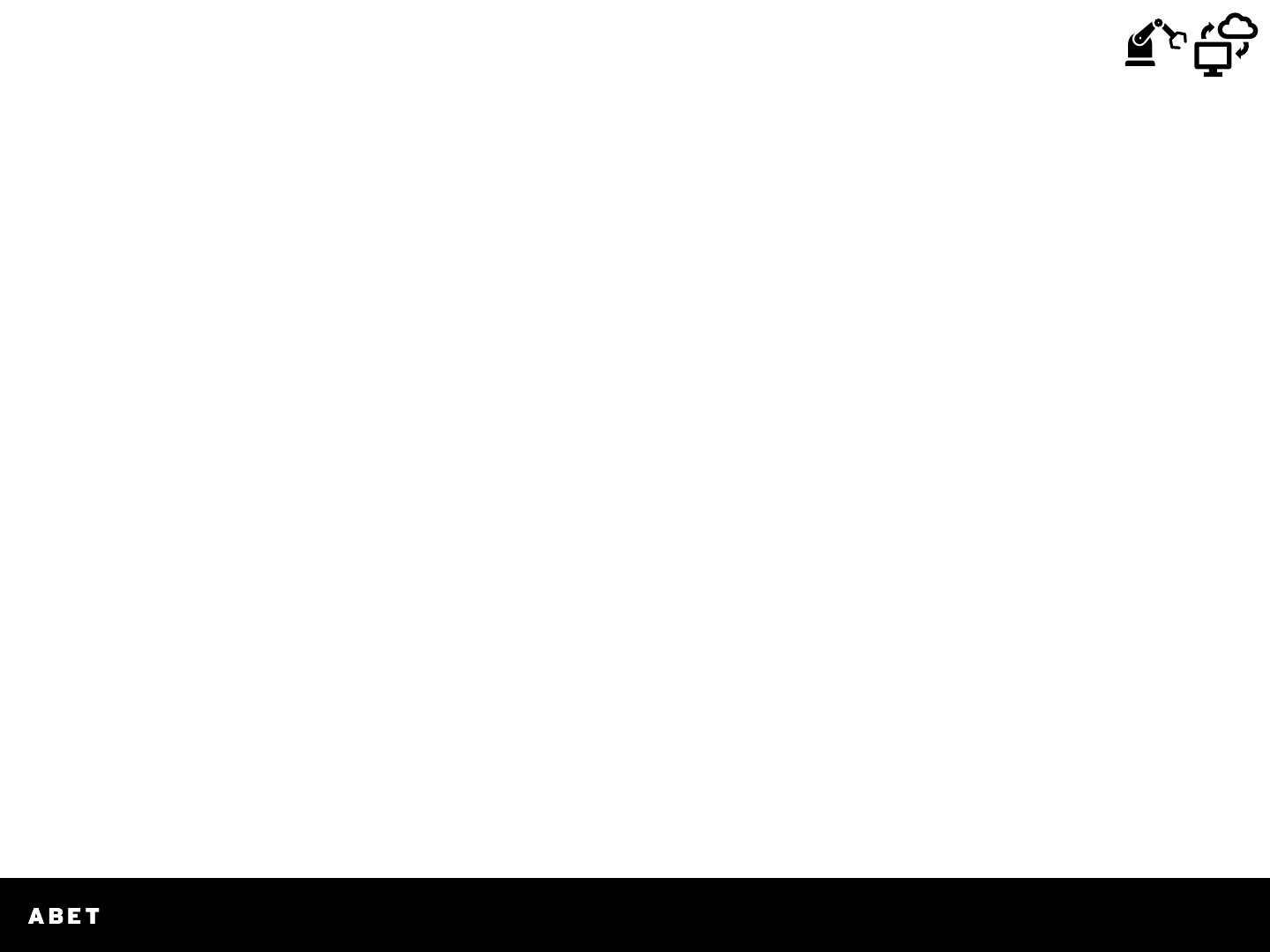
Institutional Representatives Webinar
CAC Self-Study Report (SSR)
2023-24 Accreditation Cycle
April 5 and 13, 2023
Harold Grossman
Adjunct Accreditation Director, Computing
Jean Blair
CAC Chair, 2022-23

2
Welcome!
We will be recording today’s
webinar
• Recording and slides will be available on
ABET’s website.
• All Institutional Representatives will receive a
follow-up email with a link to, and
instructions how to access, the recording and
slides at their location on the ABET public
website.
Q & A
• You have the opportunity to ask
questions throughout the webinar
using the Q&A button at the bottom
of your Zoom screen.
• We are not actively monitoring
chat, so any questions asked via the
chat function may be missed.
If we cannot address all of your questions due to time constraints, please follow up with:
Harold Grossman, hgrossman@abet.org

3
• Accreditation Timeline
• Self Study Report Preparations
• Criterion-by-Criterion Observations
• Pre-visit Activities
• Future Webinar on Preparing for the Visit
May 11 or 15
Today’s Agenda
Mutual Goal:
Work toward a successful and productive accreditation visit!

4
Accreditation Timeline, 2023-24 Cycle
4
• CAC meets to
vote on final
action
• Institution
notified
• Draft Statement
transmitted
• Within 30 days
institution
submits Due
Process
Response
• Final Statement
prepared for
Commission
• Visits conducted
• Current findings
shared
• Institution sends
7-Day Response
• Draft Statement
Prepared
Institution
requests
accreditation
• Institution
prepares Self-
Study Report
• ABET assigns
team
• Institution
approves team
Jan-Jun
2023
Accreditation
Request
&
Team Formed
Sept 2023-
Jan 2024
Visit
&
Follow-up
Oct 2023-
Mar 2024
Due Process
&
Final
Statement
July-Aug
2024
CAC
Commission
Action
Jul-Nov
2023
Prior to visit
• Team studies SSR
• (Institution
provides access
to display)
• If virtual,
institution
records facility
tours
• (Team asks
clarifying
questions)

5
Self-Study Report (SSR)
Preparations

6
Begin by collecting accreditation materials (2023-2024):
From https://www.abet.org/accreditation/accreditation-criteria/
• Accreditation Criteria
• Program Evaluator Workbook (contains the Program Evaluator
Worksheet and Program Evaluator Report)
• Accreditation Policy and Procedure Manual (APPM)
From https://www.abet.org/accreditation/accreditation-criteria/self-study-
templates/
Self-Study Questionnaire/Template
Gather ABET Materials
6

7
Begin by collecting accreditation materials (2023-2024):
From https://www.abet.org/accreditation/accreditation-criteria/
• Accreditation Criteria
• Program Evaluator Workbook (contains the Program Evaluator
Worksheet and Program Evaluator Report)
• Accreditation Policy and Procedure Manual (APPM)
From
https://www.abet.org/accreditation/accreditation-criteria/self-study-
templates/
Self-Study Questionnaire/Template
Gather ABET Materials
7

8
You might benefit from having readily available as you write:
• Your document describing your review and revision of
Program Educational Objectives process (Criterion 2)
• List of your primary constituencies
• Minutes of review and/or revision meetings
• Your document describing your Continual Improvement
Process (Criterion 4)
• Your continual improvement products
• Minutes of continual improvement meetings
• Your curriculum requirements for the major
Know Where to Find Your Materials
8

9
• Write a distinct SSR
for each program under review.
• The primary audience is
The Program Evaluator (PEV)
The Team Chair (TC)
• Your goal: demonstrate that the program
satisfies all aspects of the Criteria and
relevant portions of the APPM. Be
Clear,
Concise,
Candid, and
Focused.
Understand the Purpose
9

10
Your goal: demonstrate that the program
satisfies all aspects of the Criteria and
relevant portions of the APPM.
The Program Evaluation Worksheet (PEW):
• Identifies, criterion by criterion, what the PEV will be looking for
• Provides key elements of each criterion that must be addressed in
the SSR
The Program Evaluator Report (PER):
• Identifies curricular requirements
• Identifies key aspects of continual improvement
processes
• Also: records transcript analysis and meetings during the visit
Put Yourself in the PEV Mindset

11
• Focuses on accreditation criteria.
• Is both a quantitative and qualitative self-assessment
Of strengths and limitations of the program.
• Should include information about:
• All methods of instructional delivery
• All possible paths to degree
• All remote or online offerings
• Should not include not-relevant-to-the-criteria information.
• Answer only the questions in the self-study questionnaire.
They are meant to focus your efforts on the task at hand.
• There will be other opportunities to share your pride and joy.
Make the PEV’s job as easy as possible.
• Must be self-contained, not rely on external hyperlinks.
The Self Study Report – Overall

12
• When: by July1, 2023
• What:
• SSR(s), each as a PDF file
• Any required supplemental materials (not display materials)
• Where: upload on your Institution’s ABET
general review page in the Accreditation
Management System (AMS)
Dashboard/Reviews/Current Reviews
• Do not send by any other means
Submitting the Self Study Report(s)

13
• Your approved Team Chair and approved PEVs will be
able to access
• the self-study,
• its appendices, and
• any supplemental materials
through the ABET secure site (AMS).
• For Transcripts:
• Institution primary contact coordinates with Team Chair
• Team Chair designates how many and how to pick for each program
• You must agree on distribution approach; uploading the (redacted)
transcripts to AMS is convenient for PEV access and secure for all
ABET Team Access to Your Materials

14
• Start now, if you have not already
• Answer all questions in the questionnaire
• Get the faculty involved in writing the self-study report
• Be sure to include a summary of any significant changes
since the last review (if this is a re-accreditation visit).
• Program name must be identical to that used in
institutional publications, the ABET RFE and on the
transcripts of graduates.
General Advice

15
Questions/Comments?
15

16
Criterion by Criterion Observations

17
Accreditation Policy and Procedure
Manual (APPM)
General Criteria
Students
Program Educational Objectives
Student Outcomes
Continuous Improvement
Curriculum
Faculty
Facilities
Institutional Support
1
2
3
4
5
7
6
8
CAC Criteria
Program Criteria
Student Outcomes
Curriculum
Faculty
3
5
6
Other Requirements
Note: all General and Program Criteria
(when applicable) must be satisfied!

18
Common Observations
• Lack of documentation on why
prerequisite requirements are/are not
being met
• Lack of evidence that students are
being properly advised
• Transcript review indicates that
students have not completed all
graduation requirements and there is
no documentation validating waiver
Record of Student/Transcript
• Evaluated using a form like this
• Program name and degree awarded
must be exactly as shown on the RFE
Criterion 1. Students

19
• Must show evidence of how review processes and their
results are documented.
• The PEO statements themselves will be reviewed for
compliance with the criteria definition of a PEO.
• PEOs are broad statements that describe what graduates are
prepared to attain within a few years after graduation.
• PEOs are based on the needs of the program’s constituencies.
• If a PEO statement does not appear to meet the criteria definition
and you work to fix that, it is imperative that the constituency
review process endorsing the new PEO statement is well
documented.
Criterion 2. Program
Educational Objectives (PEOs)

20
Common Observations
• PEOs are not framed as broad attainments
• PEOS are framed as Student Outcomes
• PEO review and revision process:
• Not all stated constituents were involved in the review process
• PEOs not reviewed periodically and systematically
• PEO review process lacks documentation
• Although not required, an illustrative table or flowchart can be helpful:
• Key constituents involved in the review of PEOs
• Timetable for those constituents’ review of the PEOs (schedule and when
last accomplished)
• Manner of the review (survey tool, meeting or process)
• How reviewed results are utilized (who does what)
Criterion 2. Program
Educational Objectives (PEOs)

21
Common Observations
• SOs (including the program-specific SO) aren’t verbatim
Note: programs jointly-accredited with another commission have
some flexibility
• SOs are not documented or not publicly stated
• Publicly stated SOs are not consistent with the outcomes
being assessed by the program
• One or more of the SOs is not included in the program’s
documented outcomes
• Program has defined additional SOs (which is permitted)
but is not assessing them
Criterion 3. Student Outcomes (SOs)

22
Common Observations – no documentation of …
• The overall continuous improvement process
• Each instantiation of evaluating the assessment data
• Each consideration of results as input to program
improvement
• (If decide on improvements)
• What is to be done
• When it will be implemented
• Assignment of responsibility for the change(s)
• When follow-up review will occur
Criterion 4. Continuous Improvement

23
Common Observations – appropriateness
• Assessment and evaluation are only at the course level,
not at the program level
• Data does not/cannot get at extent of SO achievement
• Use of course grades or exam grades as assessment data
• Use of averaging to determine attainment levels
• Assessment activity lumps multiple SOs (using same rubric)
• Overreliance on indirect evidence
• Data collected across students from multiple programs and
not disaggregated by program
• Death by assessment – too much, with too little benefit to program
Criterion 4. Continuous Improvement

24
Common Observations – complete and systematic
• Process does not address all SOs
• In total, assessment events address only a portion of an SO
• Process does not discern the extent of attainment of each SO
• Assessment methods are ad hoc or not used consistently
• Data are collected and evaluated, but the information does
not lead to improvement actions when warranted
• Seemingly inappropriate avoidance of making the process
effective for the program
For example, setting a low bar to avoid improvement action
Criterion 4. Continuous Improvement

25
• Criterion 4 is about bringing value to your
program
• … by using assessment and evaluation of
attainment levels of student outcomes to guide
continuous improvement actions
• … not by spending faculty time on collecting
and organizing uninformative assessment data
Criterion 4. Continuous Improvement

27
Questions/Comments?
27

28
General Criteria Common Observations
• Not enough computing credits
• Principles and practices for secure computing is lacking
• Local and global impacts of computing solutions is lacking
Computer Science Criteria Common Observations
• Not enough or inappropriate math
• Not enough or inappropriate Natural Science
• No exposure to ….. [any of the listed topics]
• Exposure, but not substantial coverage of ….. [any of the listed topics]
• No major project that requires integration and application of
knowledge and skills acquired in earlier coursework
Criterion 5. Curriculum

29
Cybersecurity Criteria Common Observations
• Missing coverage of “application” of CY Student Outcome
• Lacking coverage of fundamental topic(s) ….. [there are 8]
• Lacking coverage of advanced topics that build on ….
• Crosscutting concepts not cutting across ….. [there are 6]
Data Science Criteria Common Observations
• Lacking coverage of the full data science lifecycle ….. [6 parts]
• Not requiring an application area
Information Systems Criteria Common Observations
• IS environment Lacking (see definition of IS environment)
Information Technology Criteria Common Observations
• Not using the 2023-24 Criteria document
Criterion 5. Curriculum

30
General Criteria Common Observations
• Faculty numbers are not adequate for advising, interaction, or
professional development, or offering courses for students to
graduate on time
• Faculty size currently adequate but factors such as program growth
and faculty attrition could jeopardize the adequacy of faculty size
• Some faculty members lack professional development activity
• Faculty do not have the appropriate authority for program guidance
Computer Science and Information Systems
Common Observations
• No faculty member(s) has/have the qualification in the program
criteria
Criterion 6. Faculty

31
Common Observations
• Equipment needs upgrade, repair, or maintenance
• Program lacks planning for staff or other resources related to
maintenance or upgrades
• Students do not have access to appropriate modern equipment or
tools
• Faculty do not have access to appropriate modern equipment and
tools
• Space and equipment currently may be adequate, but there is
reason to believe that increased enrollments or current budgeting
trends may jeopardize it in the future
Criterion 7. Facilities

32
Common Observations
• Inadequate support for laboratories (e.g., equipment or physical
space)
• Insufficient support staff
• Evidence of excessive faculty turnover
• Lack of continuity of program leadership
• Lack of support for the program
• Environment and resources are inadequate to support attainment of
student outcomes
Criterion 8. Institutional Support

33
• Documenting program criteria compliance is as
important as documenting general criteria compliance
• If already covered elsewhere in the SSR, provide clear
references to where it can be found
Note: all General and Program Criteria
(when applicable) must be satisfied!
Reporting Program Criteria

34
• ABET offers a self-study workshop (which will have a
fee). Watch for ABET communications.
• Get SSR proofread by someone not heavily involved in
writing the program’s SSR.
• Once it is written, do a self-evaluation using the same
documents that will be used by the PEV.
• Program Evaluator Report (C341).
• Program Evaluator Worksheet (C351).
• These are available in the PEV Workbook on the ABET website.
• If you have a CAC PEV or TC available on your faculty,
ask for an evaluation of the Self-Study Report.
Self-Study Report Tips

35
Questions/Comments?
35

36
Pre-Visit Activities

37
Visiting Team
37
Team Chair (TC)
Primary Contact before & after the visit
ABET Experts
Volunteers selected by CAC ExCom
Will decide communication protocol
Program Evaluators (PEVs)
ABET Experts
Disciplinary Experts
Volunteers selected by professional
society
Observers
No vote in accreditation process
PEV in training, ABET staff or state
board member
Refresher
training
Organized
Trained &
Evaluated
by ABET
Professional
Interpersonally
Skilled
Technically
competent
Institution must approve the
team members
• Team Chair
• Program Evaluators
Can only reject a TC or PEV if a
conflict of interest is identified.
Then, a new TC and/or PEV will
be assigned.
o
o
o

38
Before the Visit — after Team Approved
38
Logistics
Transcripts
Additional
information &
supplemental
materials
Samples from each
program
Document all paths
to graduation
Clarification
of self-study
report
Additional
materials
Decision about
review modality
(virtual or F2F)
Work w/ TC on
communication
protocol
• May 11 at 4 p.m. Eastern
• May 15 at 9 a.m. Eastern
Watch for the webinar on the preparing for your CAC visit

39
Tasks to complete before July
(optional)
May
11 or 15
Prep for CAC
Visit Webinar
• Before Now
to
Evaluation
Prepare display
materials
• July 1st
Self-Study
Report Due
• May -
July
PEV
Approvals
• May -
July
PEV
Approvals

40
Before July 1, 2023
Team Chair approved.
Self-Study report uploaded.
Evaluation dates set.
PEV(s) approved.
Finish collecting all course materials, and assessment documentation.
40
Be prepared to provide after July 2023
Transcripts for each program being reviewed.
Team chair will inform you about the number/type of transcripts.
Student names should be removed and replaced by a tracking code.
Explanation and documentation of course substitutions.
Documentation of approval of transfer/substitution of courses.
Graduation audit form or process documentation.
Follow-up with Team Chair: Transcript and Enrollment documentation

41
• Suppose after you submit the SSRs then …
• You find mistakes on your own, or
• The visit team asks you questions, and you realize
some items are missing, or insufficient, or incorrect.
• Do you redo the SSR? NO
The purpose of the SSR is to get the review started. Once you
submit, the SSR is done!
• If you need to make additions or corrections …
Just provide them to the Team Chair as supplements.
After July 1, 2023

42
Questions? Comments?
CAC Contacts
Harold Grossman, Adjunct Director - Computing:
hgrossman@abet.org
David Gibson, CAC Chair, 2023-24: dsgibson@comcast.net
Jean Blair, CAC Chair, 2022-23: jean.blair@westpoint.edu
Rajendra K. Raj, CAC Chair, 2021-22: rkr@cs.rit.edu
ABET HQ – Accreditation Contacts
Jane Emmet, Senior Director, Accreditation Operations
Tom Walker, Manager, U.S. Accreditation
Sherri Hersh, Manager, International Accreditation
Anna Karapetyan, Coordinator, International Accreditation
• May 11 at 4 p.m. Eastern
• May 15 at 9 a.m. Eastern
Watch for the webinar on the preparing for your CAC visit

